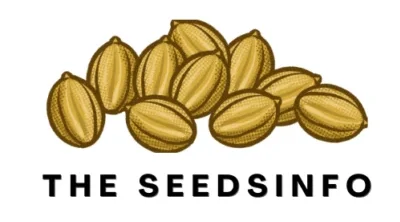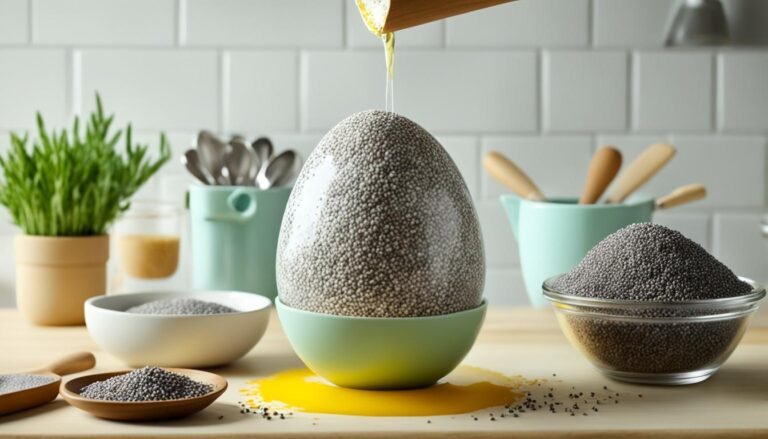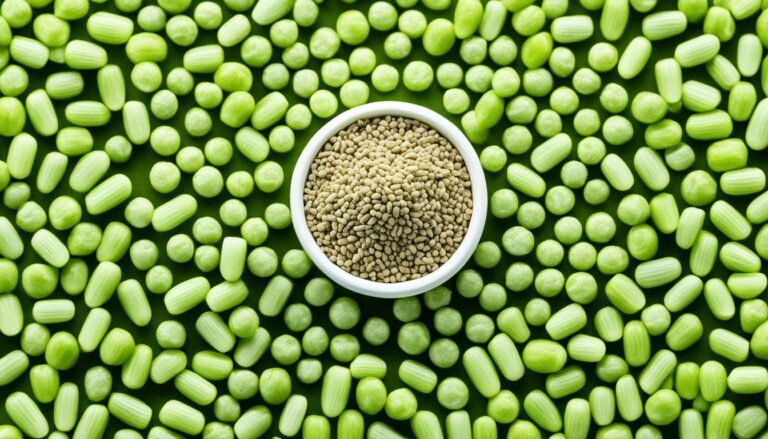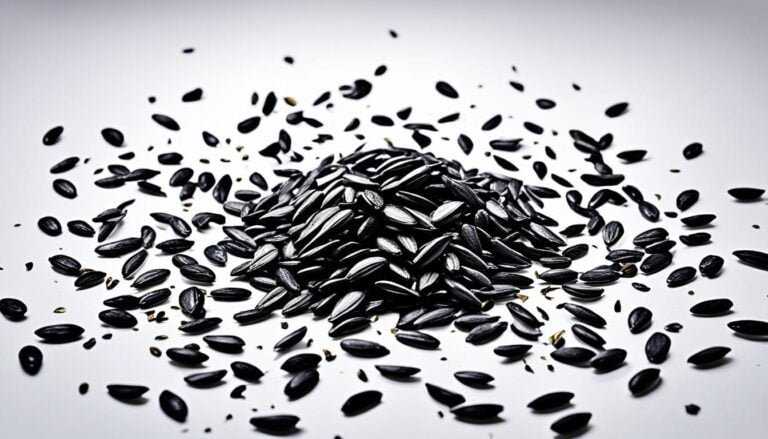Quinoa Seeds: Superfood for Healthy Living

Quinoa is an ancient grain, once held in high regard by the Incas. It has an amazing 86% antioxidant capacity, beating out many other grains. This superfood is becoming a staple in many diets, especially in the United States.
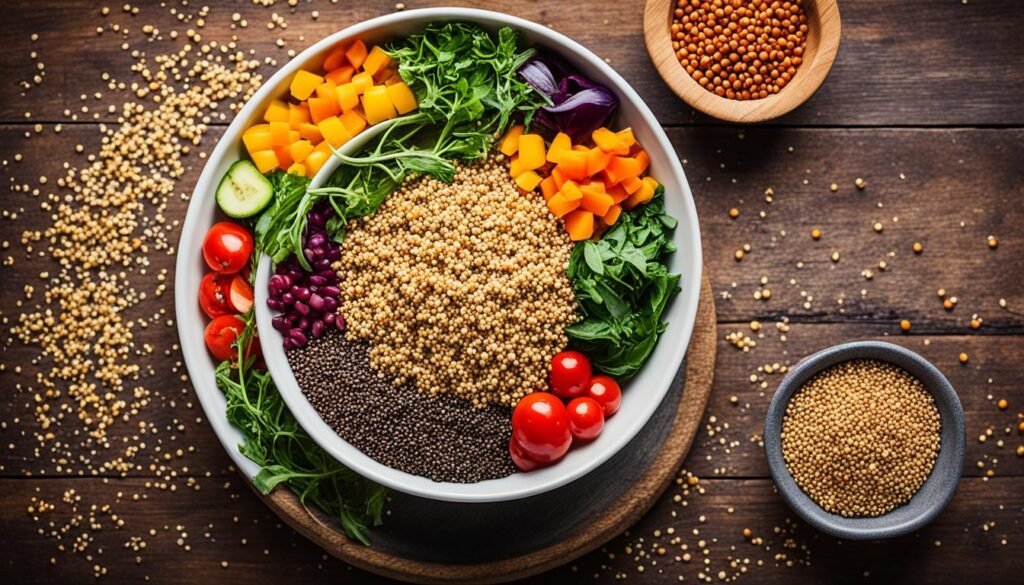
What makes quinoa stand out is not just its healthy reputation. It’s gluten-free and full of protein, fiber, vitamins, and minerals. This makes it a great choice for anyone looking to eat healthier.
Quinoa isn’t just healthy – it’s also versatile. It can help lower cholesterol and manage the risk of diabetes. Just by adding it to your meals, you can get creative. Use it in salads, make a hearty bowl, or even incorporate it into baked goods.
Introduction to Quinoa: An Ancient Grain
Quinoa is a super seed, known as the “mother grain,” grown in the Andes for over 5,000 years. It was the main food for peoples like the Inca. Since then, it’s become a favorite in many places worldwide.
Origin and History of Quinoa
Quinoa is not a true grain but is like seeds from plants that are part of the spinach and beet family. It’s a plant that can get really tall, up to 9 feet. The seeds come in many bright colors and are super small, about 2 mm wide. They can start growing in just 24 hours if the conditions are right.
Long ago, the Inca people saw quinoa as a special and important crop. It was nearly lost after the Spanish arrived in the 1500s. But it managed to come back and is now grown all over, including places in China and North America.
Quinoa: A Nutrient-Dense Superfood
Quinoa is called a superfood because it is very nutritious. It has lots of protein, fiber, and many vitamins and minerals. These help keep us healthy and can prevent illnesses.
Quinoa is very tough, handling cold well and growing in rough soils. Because of this, it’s exciting for places where crops don’t normally grow. Quinoa is seen as a key food for the future, offering a nutrition-packed option for people.
Nutritional Profile of Quinoa Seeds
Quinoa is known as a superfood because of its great nutritional benefits. It’s a top choice for quinoa protein and has all the essential amino acids. Quinoa is also high in fiber, vitamins, and minerals.
Protein and Essential Amino Acids
Quinoa is unique because it has all nine essential amino acids. This includes lysine, which is not easy to find. Cooked quinoa has a 14.6% protein content, great for plant-based eaters.
Fiber, Vitamins, and Minerals
Quinoa packs over 5 grams of fiber in every cooked cup. It’s also rich in key vitamins and minerals like folate, magnesium, iron, zinc, and manganese. Its blend of fiber, vitamins, and minerals helps make it a superfood.
| Nutrient | Amount per Cooked Cup (185g) |
|---|---|
| Calories | 222 |
| Protein | 8.14g |
| Fiber | 5.18g |
| Manganese | 1.17mg |
| Iron | 2.76mg |
| Folate | 77.7mcg |
| Magnesium | 118mg |
Quinoa’s mix of quinoa protein, essential amino acids, fiber, vitamins, and minerals makes it a standout superfood. It’s good for improving health and well-being.
Quinoa Seeds: A Complete Protein Source
Quinoa is unlike other grains we know. It shines as a complete protein, having all nine vital amino acids. This is special because many plant-based proteins miss one or more of these amino acids.
This special feature makes quinoa perfect for vegetarians and vegans. It helps them get all their needed proteins from plants. They can be sure they’re getting all the essential amino acids for their health.
In just one cup of cooked quinoa, you’ll find a lot of good stuff. This includes 222 calories, 8 grams of plant-based protein, and 5 grams of fiber. Plus, you get nutrients like folate, vitamin B6, and many minerals.
This rich mix of quinoa complete protein, fiber, and nutrients makes it great for any diet. It’s perfect for vegan protein plans or if you just want a healthy whole grain in your meals.
Being gluten-free and easy to cook, quinoa fits well in many dishes. It’s a smart choice for anyone wanting to mix up their protein options and stay healthy.
Gluten-Free and Versatile
Quinoa is an amazing grain, especially for those who avoid gluten. It’s not like many other gluten-free foods found in stores. Quinoa is a natural, whole food that’s packed with nutrients. Because of this, it fills in the nutritional gaps that a gluten-free diet might have.
This superfood is full of fiber, folate, and iron. These are essential nutrients often missing in gluten-free meals. Using quinoa can make your diet healthier and still keep you away from gluten.
Benefits for Gluten Intolerance
For people with gluten problems like celiac disease or sensitivity, quinoa is key. It’s a gluten-free grain that’s safe and full of important nutrients. Adding quinoa to your meals gives you these nutrients without the gluten issues.
Quinoa is very adaptable, fitting into many dishes, sweet or savory. You can have it in breakfasts, salads, and more. Its taste and texture work well in place of rice or couscous. And with various types like white, red, and black, there are so many ways to cook with it.
No matter if you need to avoid gluten or you’re just looking for new cooking ideas, quinoa is a great choice. It can add new flavors and benefits to your meals. So, try out this ancient grain and enjoy the goodness of a gluten-free and quinoa-based diet.
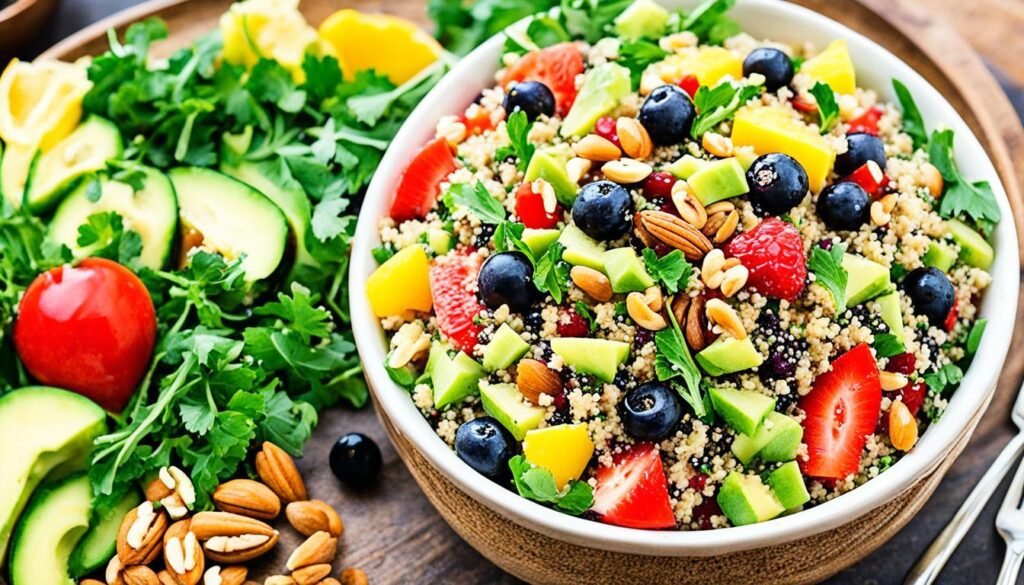
Antioxidant and Anti-Inflammatory Properties
Quinoa is an ancient superfood. It’s not just a grain; it’s packed with plant compounds that do good for your body. These seeds have flavonoids like quercetin and kaempferol. They have strong antioxidant and anti-inflammatory abilities.
These plant compounds from quinoa can shield your cells from harm by free radicals. They fight off these dangerous molecules. Adding quinoa to what you eat might boost your health in many ways.
The antioxidant and anti-inflammatory powers of quinoa help your immune system and cut down the risk of some diseases. Inflammation is a big part of many health issues. So, these effects are very helpful.
| Quinoa Compound | Health Benefits |
|---|---|
| Quercetin | Potent antioxidant, anti-inflammatory, anticancer, and anti-diabetic properties |
| Kaempferol | Exhibits antioxidant, anti-inflammatory, and anti-cancer activities |
| Saponins | Demonstrate anti-diabetic, anti-cancer, and anti-inflammatory effects |
| Phenolic Compounds | Possess antioxidant, immune-regulating, and anticancer properties |
Using quinoa in your meals lets you benefit from these healthy plant compounds. It’s a great way to support your health and feel good.
Quinoa Seeds for Digestive Health
Quinoa, the ancient Andean superfood, is great for your digestive health. It’s full of quinoa fiber, offering over 5 grams for every cooked cup. This fiber helps by making you go to the bathroom more often and feeding good bacteria in your stomach.
It also keeps you feeling full, which is good for managing your weight. Adding more quinoa gut-friendly foods to your diet helps your stomach and gut work better.
High-Fiber Content
Quinoa’s claim to fame is its high fiber. Cooked quinoa gives you 5 grams of quinoa digestibility and quinoa digestive health per serving. This rich fiber source aids in keeping your bowel movements regular and your gut full of healthy bacteria.
Easy Digestion
Compared to other grains, quinoa is easier on your stomach. This is because it has less antinutrients like saponins and phytic acid, which block nutrient absorption. Preparing quinoa by rinsing, soaking, or sprouting it decreases these antinutrients. This makes the nutrients in quinoa easier for your body to absorb and use.
Eating more quinoa gut health supports a happy digestive system. Quinoa, packed with fiber and easy to digest, is a top pick for a healthy gut.
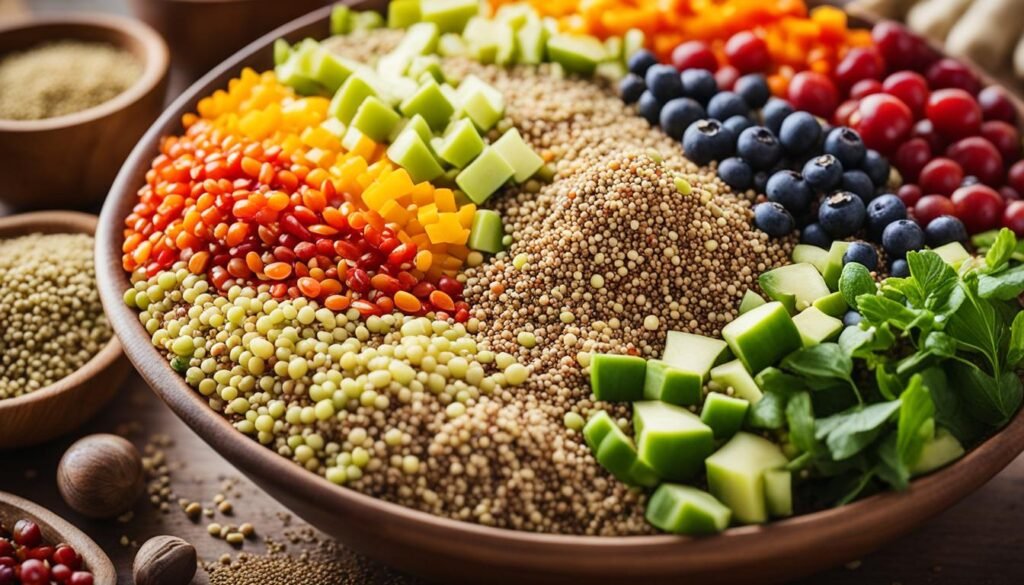
Potential Health Benefits of Quinoa Seeds
Quinoa is an ancient grain from the Andes that people are loving more these days. It’s packed with good stuff for your body. Adding quinoa to your meals might provide health perks. These include better heart health, controlling diabetes, and keeping your metabolism in check.
Lowering Cholesterol
Quinoa is known to lower bad cholesterol, or LDL. It does this by its fiber binding to bile acids. This process makes the liver use up more cholesterol to create bile acids, lowering LDL in the blood. Eating quinoa may improve your lipid profiles and lower your heart disease risk.
Promoting Heart Health
Quinoa does more than control cholesterol. It’s rich in good fats like monounsaturated and omega-3. These can fight inflammation and aid your heart’s health. Plus, the antioxidants in quinoa help fight off heart diseases by battling oxidative stress and inflammation.
Managing Diabetes Risk
Quinoa could be key in managing diabetes. It’s high in fiber and protein, which keeps your blood sugar steady and makes insulin work better. Quinoa also has lots of magnesium, linked to a lower diabetes risk. Adding quinoa to a healthy diet helps keep your blood sugar in check and lowers your diabetes risk.
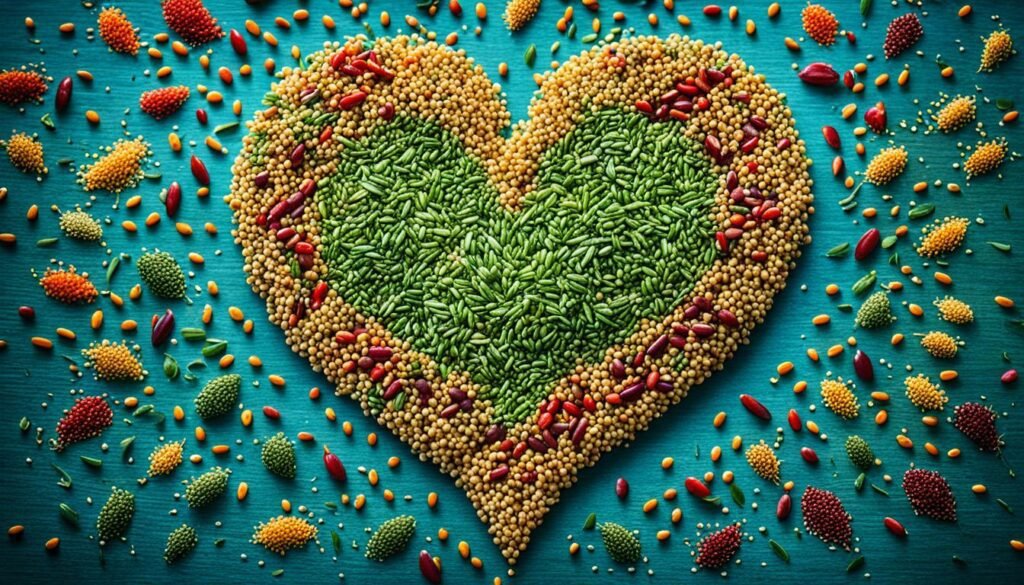
Knowing quinoa’s health perks helps you make better food choices. If you want to boost your heart health, control diabetes, or just feel better, try adding quinoa to your meals. It’s a smart move for a healthy life.
Incorporating Quinoa Seeds into Your Diet
Quinoa is a superfood full of nutrients that’s easy to add to your meals. You can use it to get more whole grains, up your protein, or try something new in the kitchen. I’ll share tips and tasty recipes to help you enjoy this ancient grain.
Cooking and Preparation Tips
To cook quinoa, use a 1:2 ratio of quinoa to liquid. This can be water or broth. First, bring it to a boil, then lower the heat to simmer for about 15-20 minutes. This way, the quinoa will come out fluffy.
Some quinoa might taste better if you rinse it before cooking. Rinsing removes a bitter substance called saponins. Doing this helps the quinoa taste and feel great.
Quinoa Recipes and Ideas
Quinoa fits well in both sweet and savory dishes. You can use it in salads, bowls, pilafs, or porridges for breakfast. It’s also a good swap for rice, couscous, or other grains. With its nutty taste, it mixes easily with various foods. So go ahead and have fun trying quinoa in different ways.
- Try quinoa breakfast bowls with fresh fruit, nuts, and a drizzle of honey or maple syrup.
- Incorporate quinoa into vegetable stir-fries or quinoa fried rice for a protein-packed meal.
- Bake quinoa-based muffins or cookies for a healthier snack option.
- Make quinoa burgers or quinoa veggie patties for a nutritious and satisfying meal.
- Use quinoa as a base for quinoa salads with your favorite vegetables, herbs, and dressings.
There are so many ways to enjoy quinoa seeds. If you’re looking to cook quinoa or need quinoa recipes, it’s a top pick. This ancient food is a flexible, tasty choice for anyone wanting to eat healthy.
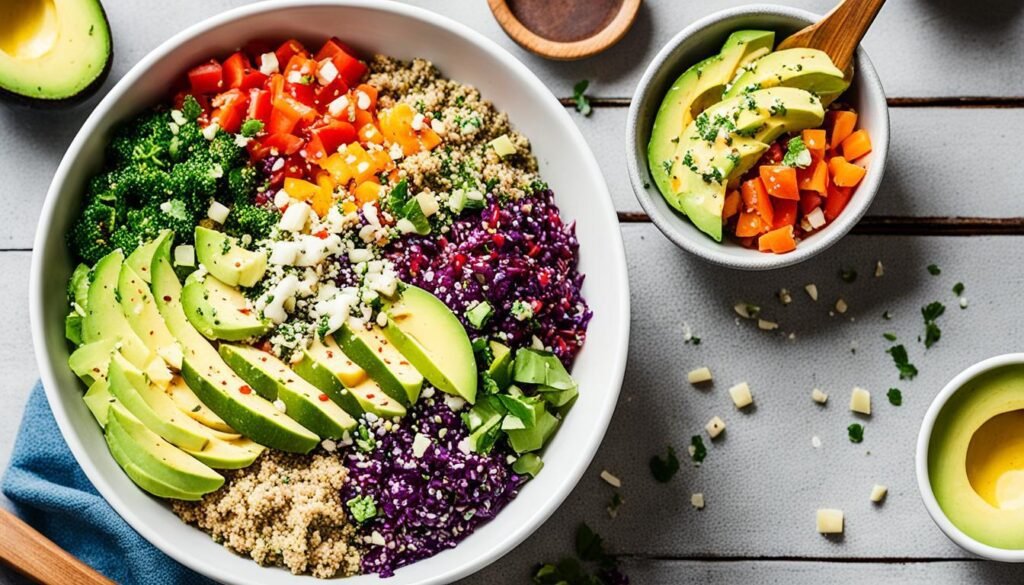
Possible Quinoa Allergies and Reactions
Quinoa is usually safe for most people. But a few may get allergies or stomach problems. This happens because of the saponins on the quinoa seed’s shell.
Allergies to quinoa might show up as hives, rash, or even trouble breathing. Some might find it hard to digest, causing bloating or gas. But, cleaning or soaking quinoa can help lower saponin levels for easier digestion.
In rare cases, quinoa can cause severe reactions. This may lead to anaphylaxis with symptoms like fast heartbeat and the inability to breathe. Immediate medical help is necessary for these reactions.
Although uncommon, quinoa allergies can be serious. They might lead to anaphylactic reactions. Those suspecting an allergy should see a doctor. They might need tests to check for the allergy or find other causes.
If you’re allergic or have trouble with quinoa, check food labels carefully. Avoid quinoa and foods with it. You can use substitutes like rice, barley, or couscous.
| Grain | Protein (g) | Fiber (g) | Fat (g) |
|---|---|---|---|
| Quinoa | 4.4 | 2.8 | 1.9 |
| Buckwheat | 3.4 | 3.0 | 0.9 |
| Barley | 3.5 | 1.9 | 0.4 |
| Wheat Berry | 4.4 | 2.0 | 0.9 |
| Freekeh | 4.1 | 3.8 | 1.3 |
The table compares quinoa to other grains. It helps those with allergies find safe alternatives to quinoa.

Conclusion
Quinoa has come a long way, from an Andean staple to a global superfood. Its exceptional nutrients and flexibility are truly impressive. This grain is packed with complete proteins, fibers, antioxidants, and anti-inflammatory agents. Adding it to your diet can change your health journey.
If you want more gluten-free choices or a plant protein, quinoa is a great option. It’s not just healthy but also tasty. Learning about what makes quinoa special makes incorporating it into meals easy. You can enjoy the benefits of its amazing nutrients.
The quinoa market keeps getting bigger, thanks to people wanting healthier, eco-friendly foods. This means the future for quinoa is very promising. Making quinoa a regular part of your diet can improve your health. There’s so much you can do with quinoa, and it’s just the beginning.
FAQ
What is quinoa, and why is it considered a superfood?
Quinoa is a rich, ancient grain filled with nutrients. It’s gluten-free, high in protein, fiber, vitamins, and minerals. Because of this, it’s seen as a superfood in many parts of the world. People love quinoa for its health benefits and the variety it adds to meals.
Where does quinoa come from, and how long has it been a part of the human diet?
Quinoa comes from the Andes in South America and has a long history there. People have been growing it for thousands of years. It was very important to the Inca people and known as the “mother grain.” Today, people all over the world enjoy quinoa.
What are the key nutrients found in quinoa?
Quinoa is full of important nutrients like protein, fiber, and various vitamins and minerals. It has all nine essential amino acids, which is rare for a plant food. It’s a great choice if you want to eat proteins that aren’t from animals.
How does quinoa compare to other grains in terms of protein?
Quinoa is a great source of protein, especially for plants, with 8 grams in a cooked cup. It offers all nine essential amino acids. This makes it very valuable, especially for vegetarians or vegans.
Is quinoa gluten-free, and how can it benefit those with gluten sensitivities?
Yes, quinoa doesn’t have gluten, so it’s good for people who need to avoid it. It’s much richer in nutrients than many other gluten-free options, like those often found in stores. With quinoa, people can eat a well-rounded diet even without gluten.
How versatile is quinoa in the kitchen, and what types of dishes can it be used in?
Quinoa’s use goes far beyond just being healthy. You can cook it in many fun and tasty ways. It works for everything, from breakfast to salads, and even main dishes like pilafs. You can swap it out for rice in many recipes. Quinoa comes in different colors too, like white, red, and black, which adds to its versatility.
What are the potential health benefits of the plant compounds found in quinoa?
There are some very good reasons to eat quinoa. It has certain plant compounds that are strong antioxidants and help fight inflammation. These can protect our bodies from harm and might help keep us healthy.
How can quinoa support digestive health?
Quinoa is excellent for your gut because it has a lot of fiber. It supports a healthy digestive system and the good bacteria in your belly. Plus, it keeps you feeling full and aids in weight management. Quinoa is also easier on the stomach than many other grains.
What are some of the potential health benefits of incorporating quinoa into the diet?
Eating quinoa might help lower your bad cholesterol. It’s also good for your heart, in part because of the healthy fats and antioxidants it contains. There’s even research that shows it could help lessen the risk of diabetes. This is because it’s high in fiber, protein, and magnesium.
How can you properly prepare and incorporate quinoa into your meals?
Cooking quinoa is easy, much like cooking rice. You should use one part quinoa to two parts water or broth. Quinoa fits well in many dishes, including breakfast porridge and salads. It’s a versatile and healthy grain to have in your kitchen.
Are there any potential downsides or allergies associated with consuming quinoa?
Most people can eat quinoa without any problems. But, a few might have allergies or find it hard to digest. This could be because of saponins on the seed. Washing quinoa well before cooking can remove these saponins, making it easier on the stomach for most people.
